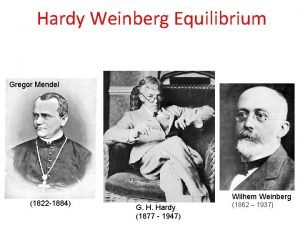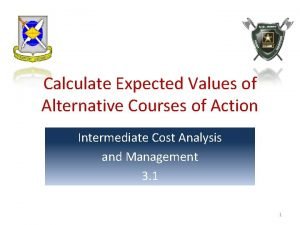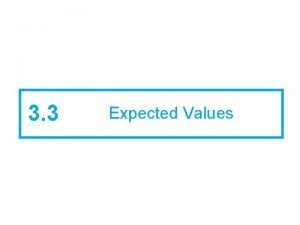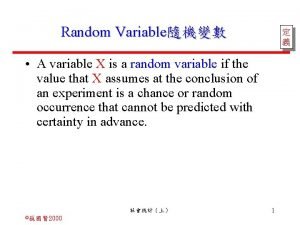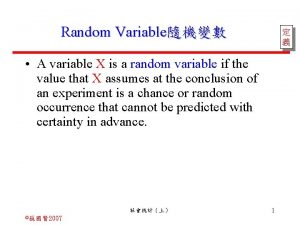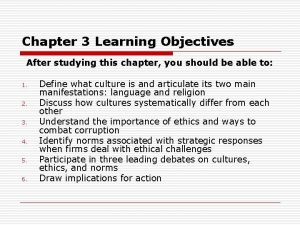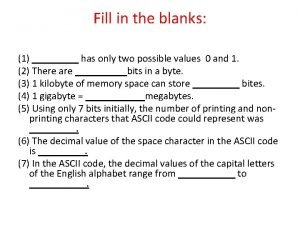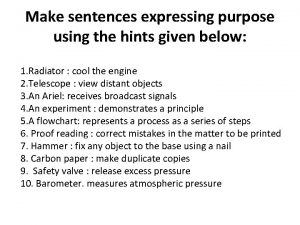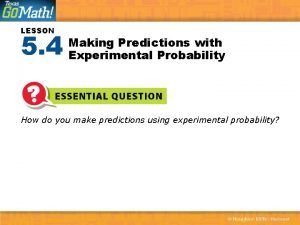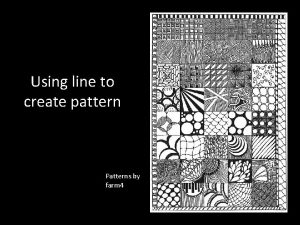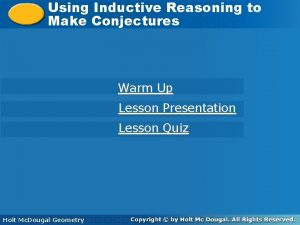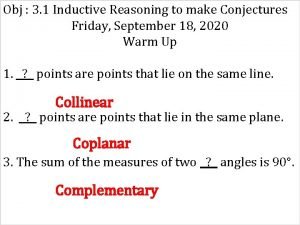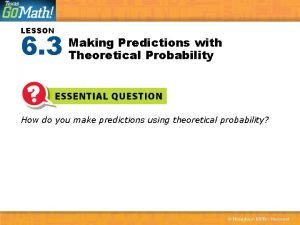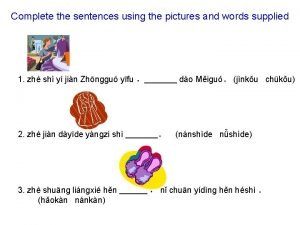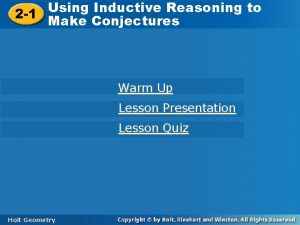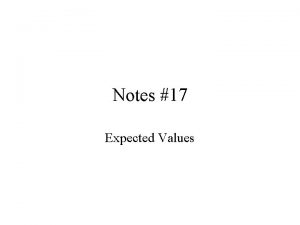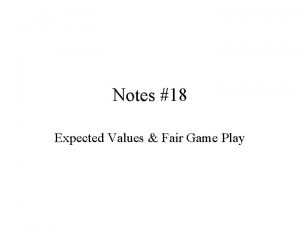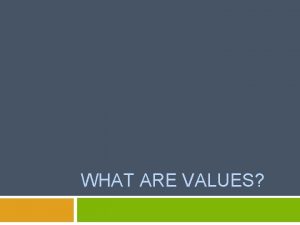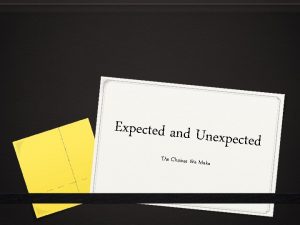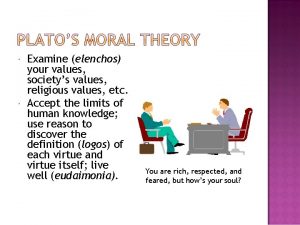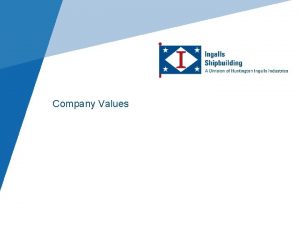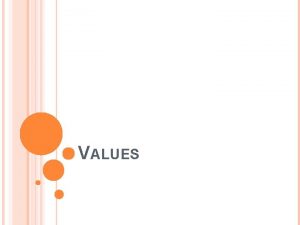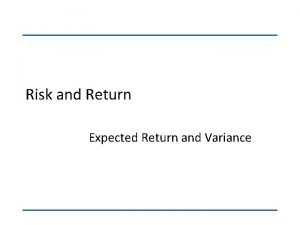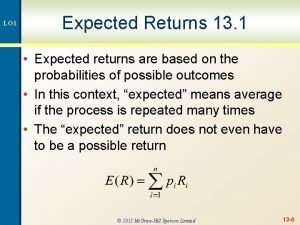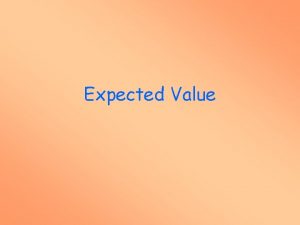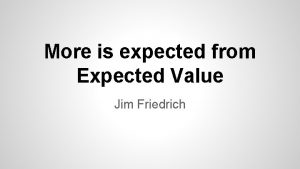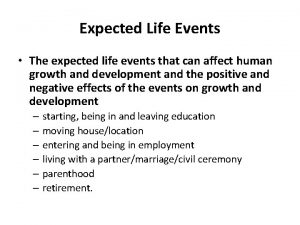Notes 19 Using Expected Values to make WISE


























- Slides: 26

Notes #19 Using Expected Values to make WISE DECISIONS for Game Play

Fair Games & Setting Up How Much to Charge per Game A game is considered fair, if its expected value is zero. This means that the risk you are taking to play the game is equal to the amount you can expect to win. Example 1: Suppose we play a game where you roll a regular die. If you roll an odd number (i. e. 1, 3, or 5) you get nothing, if you roll a 2 or a 4 you get $12, if you roll a 6 you get $60. What should be charged to make this game fair?

Set-up 1) Make a table of the possible outcomes & Cost to Play. 2) Complete the “Payoff” for each outcome and their probability of occurrence. 3) Set “ – X ” to represent the cost to play the game. The probability is 100% (or 1) that you will lose -$X to play the game. Outcome Payoff (x) $0 P(x) $12 2/6 6 $60 1/6 Cost to Play -X 1 1, 3, 5 2, 4 3/6

4) Solve for the Expected Value 5) Set E(x) to zero and solve : 6 ) FINAL ANS: If the House charges $14 to play this game, the E(x) will be zero. The player and the House will break even. This will make the game ___FAIR_____. a) If the House charges More than $14, then it favors the House. b) If the House charges Less than $14, then the game will favor the player.


Notes #20 USING E(X) TO MAKE WISE DECISIONS


Ex. 1: “Who Wants to be a Millionaire? ” Let’s say you’re at the $125, 000 question with no life-lines. The question you get is the following • Which Harry Potter character was the hero in the story? A. Harry Potter B. Neville Longbottom C. Severus Snape D. Hermione Granger

Given Conditions a) If you get the question right you will be at $125, 000. b) If you get the question wrong you fall back to $32, 000. c) Your third option is to walk away with $64, 000. Q: What to do, what to do? Use Expected Values to determine your answer.


Answer Options Payoff P(x) 1 correct answer $125, 000 1/4 3 incorrect answers $32, 000 3/4 What is our expectation “E(x)”? E(x) = $125, 000(1/4) + $32, 000(3/4) = $55, 250 < $64, 000 (walk away value). FINAL ANSWER: Take your money and RUN!

What if we had a 50/50 Then 2 of the choices would vanish. Now the choices left will be A. Harry Potter C. Severus Snape What to do, now?

Number Payoff P(x) x P(x) 1 correct answer $125, 000 1/2 $125, 00 x ½ 1 incorrect answers $32, 000 1/2 $32, 000 x ½ What is our expectation “E(x)”? E(x) = $125, 000(1/2) + $32, 000(1/2) = $78, 500 > $64, 000 [walk away value]. FINAL ANSWER: Take the guess, and hope for the best!

FINAL ANSWER Which Harry Potter character was the hero in the story? The answer is C. Severus Snape

Ex 2: Decision Theory (Investing in Stocks or Game Show) This can be used to reason numerically which is a correct decision to make by comparing expected values. Example A venture capital firm can invest in two different companies. Company A has a 40% chance of earning a $80, 000 profit and a 60% chance of a $12, 000 loss. Company B has a 70% chance of earning a $50, 000 profit and a 30% chance of a $40, 000 loss. Which is the better investment? To do this we compute the expected amount earned from each investment.

Company A Company B Amt Earned (x) P(x) $80, 000 0. 40 $50, 000 0. 70 -$12, 000 0. 60 -$40, 000 0. 30 E(x) =0. 40 (80000)+ 0. 6(-12000) = $24, 800 E(x)=0. 7(50000)+0. 3(-40000) = $23, 000 ANS: Investing in Company A would be better it has an expected return of $24, 800 compared to company B with an expected return of $23, 000.


Ex. 3 Investing in Stocks Expected Investment Profits Mark intends to invest $6, 000 in one of two companies. His research is presented in the tables below: Company ABC Company PDQ Profit/Loss (x) Probability P(x) - $400 0. 2 $600 0. 8 $800 0. 5 $1000 0. 2 $1300 0. 3 a. What are the expected profits (or loses) for each company? E(x) = -400 (0. 2) + 800 (0. 5) + 1300 (. 3) E(x) = 600 (0. 8) + 1000 (0. 2) E(x) = -80 + 400 + 390 E(x) = 480 + 200 E(x) = $710 Profit E(x) = $680 Profit

• Evaluating an Insurance Policy Suppose that you want to insure a laptop computer, an i. Phone, a trail bike, and your textbooks. a) If all of your items were stolen, how much money is the insurance company expected to pay in claims on your policy? b) Is $100 a fair premium for this policy?

a) If all of your items were stolen, how much money is the insurance company expected to pay in claims on your policy? E(x) = $40 + $12 + $6 + $32 = $90 ANS: The insurance company is expected to pay out, on average, $90 for your claim.

Evaluating an Insurance Policy b) Is $100 a fair premium for this policy? (Premium is how much the insurance company will charge you to cover your items. ) ANS: The $90 tells us that if the insurance company were to write one million policies like this, it would expect to pay 1, 000 × ($90) = $90, 000 in claims. They will pay out a sum of $90, 000. If the company is to make a profit, it must charge more than $90 as a premium, so it seems like a $100 premium is reasonable. Policy Price per Student: $100 # of Customers: 1, 000 Gross Gains: $100, 000 Net Gains: Gross Gains – Pay outs = $100 mil – $90 mil = $10 mil (Insurance Co. keeps)

Main Purpose of Using Expected Values in Game Playing Decisions • Use Math to determine when to QUIT before it’s too late! Life Lessons: #1: If the E(x) is less than what you already won, STOP & WALK AWAY! #2: If the E(x) is greater than what you already have/won, then continue playing.

Get to Know Card Playing 4 Suits For each Suit: “ 9” Number Cards: 2, 3, 4, 5, 6, 7, 8, 9, 10 “ 3” Face Cards: Jack, Queen, King + “ 1” Ace: Per Suit 13 cards total

Example 2 a (Making Money for the player or for the House) If you spin the spinner to the right, a person has agreed to pay you the amount shown in the color it lands on. What is the expected value for you to win playing this game? $ 10 $5 $ 40 We begin by making a table of all possible numbers that can result along with their probabilities. Cost to Play Payoff Net Gain/Loss (x) P(x) $0 $5 +$5 0. 50 $0 $10 +$10 0. 25 $0 $40 +$40 0. 25 Expected Value = (5)(0. 5) + (10)(0. 25) + (40)(0. 25) = 2. 5 + 10 = $15 This means on average a person could expect to win 15 dollars each time they play this game, and the House loses $15.

Example 2 b (Making Money for the player or for the House) If you spin the spinner to the right, a person has agreed to pay you the amount shown in the color it lands on. What is the expected value for you to win playing this game? $ 10 $5 $ 40 We begin by making a table of all possible numbers that can result along with their probabilities. If they charge you $ 20 to spin this each time what is your expected value? Cost to Play Payoff Net Gain/Loss [Payoff – Cost to Play] P(x) $20 $5 $5 - $20 = -$15 0. 50 $20 $10 - $20 = -$10 0. 25 $20 $40 - $20 = $20 0. 25 Expected Value = -15(0. 5) + -10(0. 25) + 20(0. 25) = -7. 5 + -2. 5 + 5 = -5 Which means on average you should expect to lose $ 5, and the House gains $5.

Hearts Clubs Diamonds Spades
 He who walks with the wise grows wise
He who walks with the wise grows wise Five conditions for hardy weinberg
Five conditions for hardy weinberg Alternative courses of action definition
Alternative courses of action definition How to solve for expected value
How to solve for expected value Variance of the random variable
Variance of the random variable Var(x)=
Var(x)= Making wise decisions meaning
Making wise decisions meaning Western values vs eastern values
Western values vs eastern values Terminal values and instrumental values
Terminal values and instrumental values Instrumental values
Instrumental values What are the two possible values of bit
What are the two possible values of bit Concepts of human values
Concepts of human values Conversion notes brutes en notes standard wisc 5
Conversion notes brutes en notes standard wisc 5 13 fatal errors managers make sparknotes
13 fatal errors managers make sparknotes Make the lie big make it simple
Make the lie big make it simple Steve angrisano go make a difference
Steve angrisano go make a difference Make the lie big make it simple
Make the lie big make it simple Make sentences using the past simple and past continuous
Make sentences using the past simple and past continuous Purpose sentences
Purpose sentences Making predictions with experimental probability
Making predictions with experimental probability Patterns of lines
Patterns of lines Using inductive reasoning to make conjectures answers
Using inductive reasoning to make conjectures answers Poem on team work
Poem on team work Conjecture
Conjecture Make predictions using theoretical probability
Make predictions using theoretical probability Complete the sentences using these words
Complete the sentences using these words Making conjectures inductive reasoning
Making conjectures inductive reasoning

